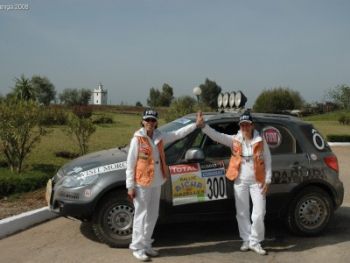 |
|
Running at competitor no 300 this year was a
new addition to the tough rally challenge, a Fiat Auto Belgio
entered
Fiat Sedici, piloted by Belgian Samiri Azmani and
Frenchwoman Catherine Torgue. |
 |
|
|
|
 |
|
The two female drivers and the team
successfully made it though the rigorous
terrain of the North African desert to the
finish line. |
 |
|
|
|
The Fiat
Sedici has taken to the North African desert and proved
its off road credentials in the Rallye Aïcha des
Gazelles piloted through the adverse terrain by an
all-female crew with the adventure supported by Fiat
Auto Belgio.
Organised for amateur and
professional women drivers, the Rallye Aïcha des Gazelles is today the reference
standard for female motorised adventure; it
is the only
women’s rally in the world that brings together amateur
women between 25 and 65 years old, from all social and
cultural backgrounds and from every country.
By excluding speed, it has created another vision of
car rallies. The Rallye Aïcha des Gazelles is based on “old fashion” navigation
skills. On board their 4WDs, SUVs,
Motorbikes, Quad bikes, Trucks or Prototypes, the rally gives the entrants a
10-day challenging experience in the Moroccan Sahara. While being
off-track with just a map and compass, in autonomy, the competitors must cover
the marked out route in a minimum of kilometres.
This year's 18th
edition
of the Rallye
Aïcha des Gazelles
ran from 15-29 March, with technical checks
taking place in
France before all the competitors travelled to Morocco by
ferry for the competitive section (19-27 March). Running at
competitor no 300 this year was a new addition to the rally,
a Fiat Auto Belgio entered
Fiat Sedici, piloted by Belgian Samiri Azmani and
Frenchwoman Catherine Torgue. The two female drivers and the team,
which was additionally
supported on the event by Partenariat Fiat Maroc, Napapijri Europe
and Club Health O2 Halle, successfully made it through the
rigorous terrain of the North African desert to reach the
finish line.
Although the Rallye Aïcha des Gazelles is a return
to the roots for the “sporting” side of the adventure, safety is paramount at
all times and the organisation uses satellite tracking systems, at the cutting
edge of technology, to achieve this objective. It is this duality that makes
this competition so unusual.
The concept sees the crew cover
the predefined route, checking off all the control
points set up along the route. The objective is the same
as in all rallies: "accumulate the minimum", talking
here in
kilometres and not in minutes. Speed is not taken into
account in the ranking of the event. Each morning the
competitors draw one of the four predefined routes. They are
given a road book and draw up their route for the day. This
very succinct document only mentions the geographic
co-ordinates (30°28'560 N / 006°25'743 W) of the 6 control
points and the finishing line of the day. Three routes are
identical in time, distance and difficulties. A fourth route
is exclusively reserved for the SUV (Sports Utility
Vehicles). This special route was introduced in 2003 for the
first time and takes into account the specificities of this
type of vehicle. This separation is designed to divide all
the teams into 4 groups and thus avoid having too many on
the same route.
It is strictly forbidden for the vehicles in
the rally to follow each other or the drive together during
a leg. The competitors draw their route on the map and must
follow this itinerary whilst respecting the sporting
regulations, only using a compass (old-fashioned navigating,
GPS is forbidden). The start is given minute by minute every
morning at 6.00am and an average day lasts for 14 to 18
hours.
The Rallye Aïcha
des Gazelles is also one of the first events to commit to
adopting an environmental approach.
Over the past several years, many concrete actions have been
taken (such as operation “clean bivouac” and controlled water
management). 2007 marks a turning point with the
launching of a fundamental program for the protection of the
environment.
|